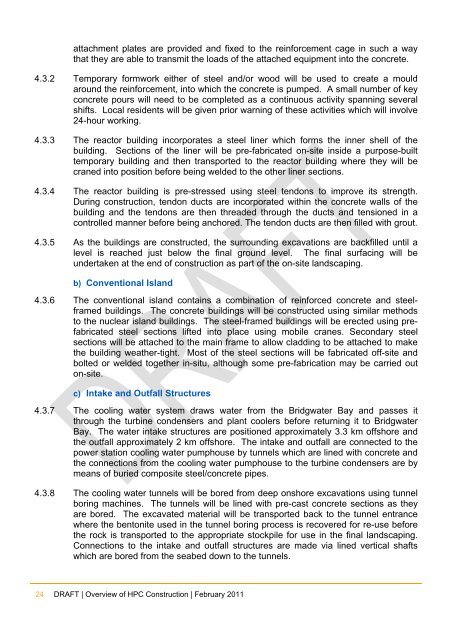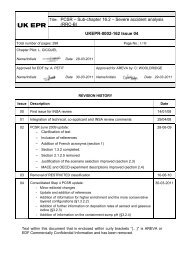Draft Overview of HPC Construction - EDF Hinkley Point
Draft Overview of HPC Construction - EDF Hinkley Point
Draft Overview of HPC Construction - EDF Hinkley Point
Create successful ePaper yourself
Turn your PDF publications into a flip-book with our unique Google optimized e-Paper software.
attachment plates are provided and fixed to the reinforcement cage in such a waythat they are able to transmit the loads <strong>of</strong> the attached equipment into the concrete.4.3.2 Temporary formwork either <strong>of</strong> steel and/or wood will be used to create a mouldaround the reinforcement, into which the concrete is pumped. A small number <strong>of</strong> keyconcrete pours will need to be completed as a continuous activity spanning severalshifts. Local residents will be given prior warning <strong>of</strong> these activities which will involve24-hour working.4.3.3 The reactor building incorporates a steel liner which forms the inner shell <strong>of</strong> thebuilding. Sections <strong>of</strong> the liner will be pre-fabricated on-site inside a purpose-builttemporary building and then transported to the reactor building where they will becraned into position before being welded to the other liner sections.4.3.4 The reactor building is pre-stressed using steel tendons to improve its strength.During construction, tendon ducts are incorporated within the concrete walls <strong>of</strong> thebuilding and the tendons are then threaded through the ducts and tensioned in acontrolled manner before being anchored. The tendon ducts are then filled with grout.4.3.5 As the buildings are constructed, the surrounding excavations are backfilled until alevel is reached just below the final ground level. The final surfacing will beundertaken at the end <strong>of</strong> construction as part <strong>of</strong> the on-site landscaping.b) Conventional Island4.3.6 The conventional island contains a combination <strong>of</strong> reinforced concrete and steelframedbuildings. The concrete buildings will be constructed using similar methodsto the nuclear island buildings. The steel-framed buildings will be erected using prefabricatedsteel sections lifted into place using mobile cranes. Secondary steelsections will be attached to the main frame to allow cladding to be attached to makethe building weather-tight. Most <strong>of</strong> the steel sections will be fabricated <strong>of</strong>f-site andbolted or welded together in-situ, although some pre-fabrication may be carried outon-site.c) Intake and Outfall Structures4.3.7 The cooling water system draws water from the Bridgwater Bay and passes itthrough the turbine condensers and plant coolers before returning it to BridgwaterBay. The water intake structures are positioned approximately 3.3 km <strong>of</strong>fshore andthe outfall approximately 2 km <strong>of</strong>fshore. The intake and outfall are connected to thepower station cooling water pumphouse by tunnels which are lined with concrete andthe connections from the cooling water pumphouse to the turbine condensers are bymeans <strong>of</strong> buried composite steel/concrete pipes.4.3.8 The cooling water tunnels will be bored from deep onshore excavations using tunnelboring machines. The tunnels will be lined with pre-cast concrete sections as theyare bored. The excavated material will be transported back to the tunnel entrancewhere the bentonite used in the tunnel boring process is recovered for re-use beforethe rock is transported to the appropriate stockpile for use in the final landscaping.Connections to the intake and outfall structures are made via lined vertical shaftswhich are bored from the seabed down to the tunnels.24 DRAFT | <strong>Overview</strong> <strong>of</strong> <strong>HPC</strong> <strong>Construction</strong> | February 2011













![6.3 - Safety Injection System (RIS [SIS]) - EDF Hinkley Point](https://img.yumpu.com/42739985/1/184x260/63-safety-injection-system-ris-sis-edf-hinkley-point.jpg?quality=85)


